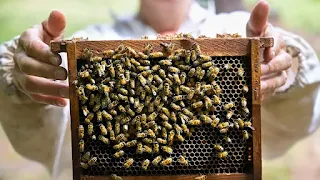Deciphering All the Buzz About Honey Bee Loss
Reports of unusually high honey bee die-offs in the first part of 2025 have been making the rounds on major news networks and in beekeeping publications. But the cause of the phenomenon is still unclear.
To make sense of the swarm of information about honey bees, we consulted David Tarpy, a University Faculty Scholar in NC State University’s Department of Applied Ecology and Extension apiculturist. Tarpy, who leads the bee research program at NC State, is an expert in honey bee queen behavior and bee genetics.
Researchers at Washington State University are projecting that commercial honey bee colony losses in the U.S. could reach 60 to 70% this year. What do you make of that estimate? How would that level of loss affect pollination-based crop production?
It’s still early, but those are the estimates based on anecdotal reports. The annual U.S. Beekeeping Survey is conducted through the month of April, so we won’t have hard numbers until those data are crunched, but things aren’t looking too good.
What this means is that beekeepers are going to have to scramble to grow their colony numbers back, which might put their pollination contracts in jeopardy. (Colonies can either be large and functional for rent in pollination, or they can be split into smaller units to grow back.) This means that growers might have an even harder time finding the managed beehives they might rent during the blooming period of their crop, which could result in decreased yields.
What is the average annual percentage of honey bee colony losses in the U.S.?
For the last 15 years since the Bee Informed Partnership survey has been conducted, managed honey bee colony loss has averaged 40% per year. We don’t have really good baseline data before that, but beekeepers say that only a 15-20% loss per year is acceptable. That means that the annual losses of honey bees are not sustainable and we need to mitigate the many underlying reasons why colonies die. That does NOT mean that honey bee colonies are in constant decline; we lose 40% per year, but then beekeepers grow the population back, so it’s really an oscillating or uncertain population rather than one constantly diminishing.
RELATED

How are honey bee losses in 2025 different than in years past?
It’s definitely higher than average, at least based on the surveys since Colony Collapse Disorder hit the headlines. I think the early reports of beekeepers pollinating California almonds in late January-early February suggested something was worse this year, and a lot of people are suspecting Varroa mite resistance to the most commonly used acaricide. Varroa is a noxious parasite where beekeepers apply pesticides to keep the bees healthy, but if the mites evolved a resistance that could definitely explain the high die-offs.
Does this year’s bee loss trend just involve honey bees or does it include other types of bees?
Definitely just honey bees, since they are different from all the other pollinators in that they live in colonies, are managed by humans, and are transported in and out of commercial agricultural settings. Native bees, most of which are solitary, live in the wild and aren’t tended to by humans. There are 20,000 species of bees worldwide, 4,000 native to North America, and about 560 indigenous to North Carolina. However, we don’t have as good baseline data on them, and they can be more susceptible to many of the same problems that affect honey bees, and many of those species ARE in decline.
Are you currently doing any research around honey bee loss?
Yes, most of our research focuses on honey bee health in one way or another. One major paradigm in the lab is to investigate queen reproductive quality in an attempt to improve the longevity and productivity of queens. Since there’s only one queen per colony as the sole egg layer, her typical lifespan of three to five years seems to be declining in recent years, so ways to improve queens could go a long way toward helping colonies and their survival.
RELATED

What are researchers doing to help pinpoint the cause of the current problem?
Parasites like Varroa, pesticides and poor nutrition have been at the top of the list for honey bee health. Right now, samples are being collected to determine what factor(s) might be overrepresented in the unhealthy colonies to help pinpoint the underlying cause.
What steps can beekeepers take to protect their hives?
What most apiculture officials say is to keep the Varroa mite population under control, make sure the bees are well-fed by being in environments with ample nectar and pollen sources, and keep the queen productive and thriving. Those three stressors account for about 90% of problems that most beekeepers experience, but it’s easier said than done to stay on top of them all season long.
What else should people know about threats to bees and other pollinators? And what can the average person do to help protect bees?
First, realize that not everything that flies and might sting you is a “bee”; yellow jackets are wasps, and they give bees a bad name. Second, recognize that not all bees are the same, and they are not all honey bees. The great diversity of native bees is important for our environment, as are managed honey bees, especially in commercial production agriculture. Third, plant, restore and preserve natural habitats with nectar- or pollen-bearing plants, as these are important food sources for bees, especially in the middle of summer when there tends to be a scarcity of blooming plants. Finally, support your local beekeepers by buying LOCAL honey and donate to research efforts that are helping to develop solutions to the unsustainable honey bee die-offs.

댓글
댓글 쓰기